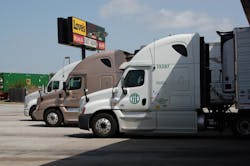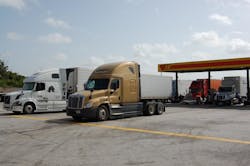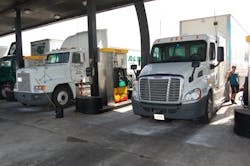In trucking’s case, this might offer a window of opportunity (of sorts) if such career “fulfillment” revolves around a lot of driving and never being in one place for very long. Then again, pay – regardless of the platitudes spouted in such surveys – is going to remain a top issue in any line of work, but especially in trucking, as the bills DO need to get paid.
So, according to a new nationwide study of 600 job seekers over the age of 18 across the U.S. conducted by recruiting firm Simply Hired, an overwhelming majority of Americans (88%) agree that it is most important to find a job that matches their personality and strengths, with a comparable majority (86%) stating that finding the “right job” is more important than finding a job quickly.
Simply Hired’s study also found that the “new” American “dream job” is a step in a career, not simply a way to pay the bills, as over two-thirds of those polled believe that a job that helps build a more fulfilling career is more important than a job that provides more money. And even more (76%) state it is important to have a career, not just a job.
Interestingly, despite recent hype to the contrary, coaching and mentoring has yet to hit the mainstream with only 14% of job seekers actively seeking professional career help, the firm found.Americans are also optimistic about the chances of finding the right match as Simply Hired’s poll found three out of four Americans agree that the right job is out there waiting to be found. And it isn’t necessarily the job they hold now, as only 35% agree that their current job represents their preferred profession.
Does bespeak of potential opportunity for trucking firms in terms of recruiting a new generation of drivers? Maybe and maybe not – but the need for “young blood” to flesh out trucking’s ranks is growing more and more acute with each passing month.
Look at some numbers compiled by Gordon Klemp, founder and president of the National Transportation Institute: roughly 56% of the drivers in for-hire fleets are 45 or older, with 22.3% above the age of 55 – with just more than half of that last number in the 62- plus category, which puts them eligible for retirement in terms of social security income.
“That remains an issue that we'll have to deal with longer term, but short term we have a very old [truck driving] force,” he explained in a conference call hosted by Wall Street investment firm Stifel, Nicolaus & Co. back in the spring.
“Obviously, if you think about what kind of person we would like to have for this kind of physically demanding job it would probably be someone who is relatively early in their career, in great physical condition, willing to work irregular hours, less likely to get injured, etc. – all pointing to people in their 20s and 30s, ideally,” he explained.But that’s not the profile trucking has, he emphasized. “And if you thought it was bad when you looked at the for-hire fleets, the private fleets are worse as 59.2% of the folks in private fleets are 45 and older,” Klemp said. “That is a huge number.”
He also noted that private fleets provide far higher pay and more consistent home time that for-fire fleets, which is one reason they take their drivers “all the way to retirement” in his words.
That pay disparity is a big deal, Klemp stressed. According to his data, the median for-hire driver W-2 income in 2013 hit $47,544, while the median pay for private fleet drivers reached $72,366.
“When I said they [private fleets] pay more, I mean they pay a lot more,” he added. “And it is a lot easier to recruit drivers with those kinds of numbers.”
That disparity is constant through the many different segments of the trucking business, too, Klemp noted. In temperature-controlled trucking service, for example, the for-hire median is $48,766 while the private fleet median is $74,109. On the flatbed side, the for-hire median is $50,124 and the private fleet median is $68,416—also a large gap.
Yet James Beriker, president and CEO of Simply Hired, pointed out that one of the trends his firm is focused on is that there’s simply no longer a “one size fits all” solution to finding and keeping workers for the long term.“There is no simple formula or calculus to define the right job; instead Americans overwhelmingly agree that it is a matter of personal fit and fulfillment,” he stressed. “People believe the right job opportunity is waiting out there, and they’re trying to figure out the best way to find it.”
David Hames, general manager of marketing & strategy for Daimler Trucks North America (DTNA), thinks one possible future tactic is to focus on the needs of what he called the “Xbox” driver, as the generation of workers in their 20s and 30s are not only comfortable with technology-laden work environments, they almost demand them as part of their job fulfillment needs.
“All they want is an easy work environment that allows them to maximize their individual profitability while they’re in the driver’s seat,” he explained during a presentation at the recent 2014 Commercial Vehicle Outlook Conference. “It’s not a stretch that they will view performance metrics as a game; a competition to see who’s the best.”
It’s something to consider at least as the hunt to recruit and retain truck drivers for the long-term goes on.




